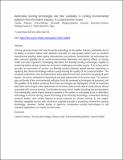| dc.description.abstract | Chrome tanning remains the most favourite technology in the leather industry worldwide due to its ability to produce leather with attributes desirable for high-quality leather such as excellent hydrothermal stability, better dyeing characteristics and softness. Nevertheless, the technology has been censured globally for its severe environmental detriments and adverse effects on human health and other organisms. Developing alternative eco-friendly tanning technologies capable of producing leather of high quality has remained a challenging scientific inquiry. This review article provides an assessment of various eco-friendly tanning attempts geared towards improving or replacing the chrome technology without compromising the quality of the produced leather. The reviewed publications have ascertained that, these attempts have been centred on recycling of spent liquors; chromium exhaustion enhancement and total replacement of chromium salts. The research gaps and levels of key environmental pollutants from the reviewed technologies are presented, and the qualities of the leather produced from these technologies are highlighted. Of all the examined alternative technologies, total replacement of chromium salts sounds ideal to elude adverse effects associated with chrome tanning. Combination tanning, which implies blending two tanning agents that individually cannot impart desired properties to the leather, is anticipated to be an alternative technology to chrome tanning. Apart from being an eco-friendly technology, combination tanning produces leather with similar features to those produced by chrome tanning. In this regard, blending vegetable tannins with aluminium sulphate provides a promising chrome-free tanning technology. However, further studies to optimize combination tanning technologies to suit industrial applications are highly recommended. | en_US |

